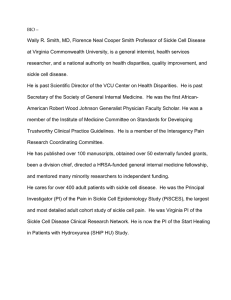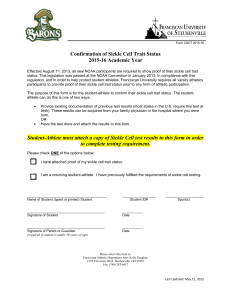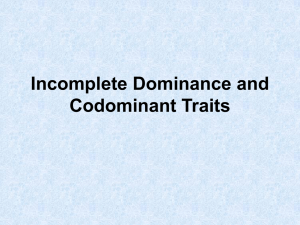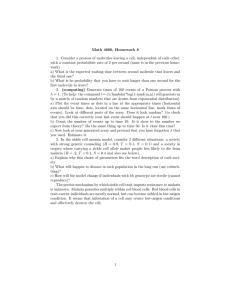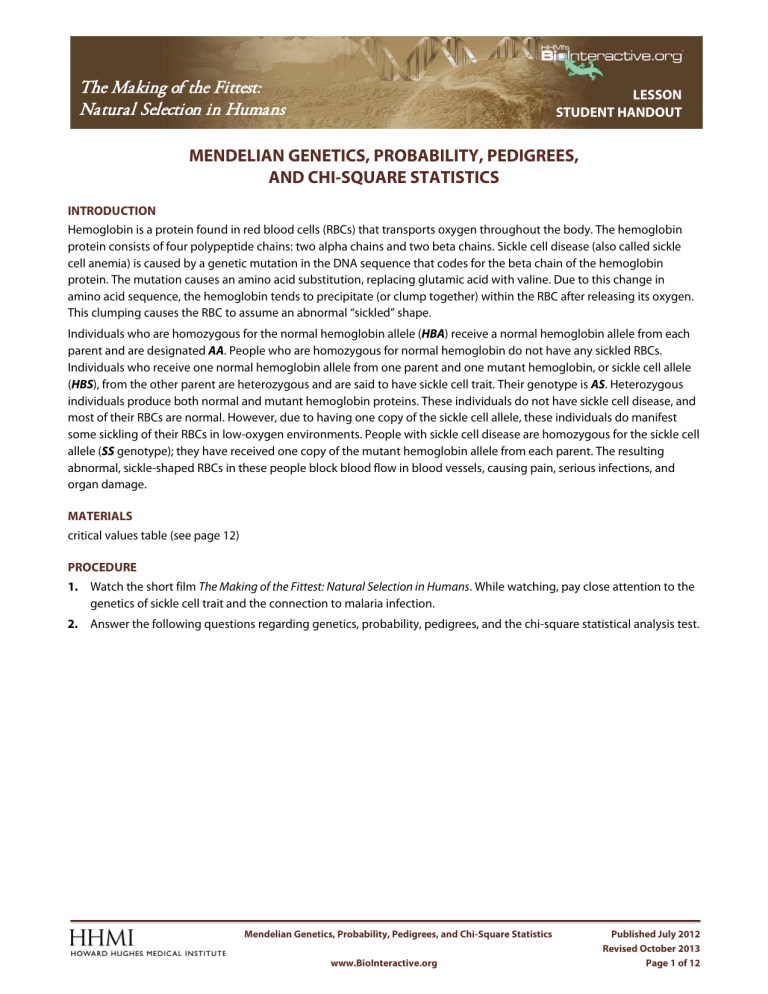
The Making of the Fittest: Natural Selection in Humans LESSON STUDENT HANDOUT MENDELIAN GENETICS, PROBABILITY, PEDIGREES, AND CHI-SQUARE STATISTICS INTRODUCTION Hemoglobin is a protein found in red blood cells (RBCs) that transports oxygen throughout the body. The hemoglobin protein consists of four polypeptide chains: two alpha chains and two beta chains. Sickle cell disease (also called sickle cell anemia) is caused by a genetic mutation in the DNA sequence that codes for the beta chain of the hemoglobin protein. The mutation causes an amino acid substitution, replacing glutamic acid with valine. Due to this change in amino acid sequence, the hemoglobin tends to precipitate (or clump together) within the RBC after releasing its oxygen. This clumping causes the RBC to assume an abnormal “sickled” shape. Individuals who are homozygous for the normal hemoglobin allele (HBA) receive a normal hemoglobin allele from each parent and are designated AA. People who are homozygous for normal hemoglobin do not have any sickled RBCs. Individuals who receive one normal hemoglobin allele from one parent and one mutant hemoglobin, or sickle cell allele (HBS), from the other parent are heterozygous and are said to have sickle cell trait. Their genotype is AS. Heterozygous individuals produce both normal and mutant hemoglobin proteins. These individuals do not have sickle cell disease, and most of their RBCs are normal. However, due to having one copy of the sickle cell allele, these individuals do manifest some sickling of their RBCs in low-oxygen environments. People with sickle cell disease are homozygous for the sickle cell allele (SS genotype); they have received one copy of the mutant hemoglobin allele from each parent. The resulting abnormal, sickle-shaped RBCs in these people block blood flow in blood vessels, causing pain, serious infections, and organ damage. MATERIALS critical values table (see page 12) PROCEDURE 1. Watch the short film The Making of the Fittest: Natural Selection in Humans. While watching, pay close attention to the genetics of sickle cell trait and the connection to malaria infection. 2. Answer the following questions regarding genetics, probability, pedigrees, and the chi-square statistical analysis test. Mendelian Genetics, Probability, Pedigrees, and Chi-Square Statistics www.BioInteractive.org Published July 2012 Revised October 2013 Page 1 of 12 The Making of the Fittest: Natural Selection in Humans LESSON STUDENT HANDOUT QUESTIONS MENDELIAN GENETICS AND PROBABILITY 1. If two people with sickle cell trait have children, what is the chance that a child will have normal RBCs in both highand low-oxygen environments? What is the chance that a child will have sickle cell disease? Write the possible genotypes in the Punnett square. Normal RBCs in high- and low-oxygen environments Sickle cell disease ____________ ____________ a. What is the chance that a child will carry the HbS gene but not have sickle cell disease? ___________________ b. What are the chances that these parents will have three children who are homozygous for normal RBCs? (Show your work.) ___________________________ c. What are the chances that these parents will have three children who have both normal and mutant hemoglobin beta chains? (Show your work.) ___________________________ d. What are the chances that all three of their children will show the disease phenotype? (Show your work.) ___________________________ e. What are the chances that these parents will have two children with sickle cell trait and one with sickle cell disease? (Show your work.) ___________________________ f. In the cross above, if you know that the child does not have sickle cell disease, what is the chance that the child has sickle cell trait? ___________________ 2. An individual who has sickle cell trait has children with an individual who does not have the HbS allele. a. What are the genotypes of the parents? ____________________ b. In the Punnett square, show all the possible genotypes of their children. State the genotype and phenotype ratios of the offspring. c. What are the chances that any one of this couple’s children will have sickle cell disease? __________________ d. If this couple lives in the lowlands of East Africa, what are the chances that one of their children would be resistant to malaria if exposed to the malaria parasite? _________________ Mendelian Genetics, Probability, Pedigrees, and Chi-Square Statistics www.BioInteractive.org Page 2 of 12 The Making of the Fittest: Natural Selection in Humans LESSON STUDENT HANDOUT 3. A woman with sickle cell disease has children with a man who has sickle cell trait. Answer the following questions. a. What are the genotypes of the parents? ____________________ b. What is the genetic makeup of the gametes the mother can produce? ___________ c. What is the genetic makeup of the gametes the father can produce? ___________ d. In the Punnett square, show all the possible genotypes of their children. Then summarize the genotype and phenotype ratios of the possible offspring. e. What are the chances that any one of this couple’s children will have sickle cell disease? _______________________________________ f. If this couple moves to the lowlands of East Africa and has children, which of their children would be more likely to survive? Explain your answer. 4. In humans, blood type is a result of multiple alleles: IA, IB, and iO. A few simple rules of blood type genetics are that • IA is dominant over iO, • IB is dominant over iO, and • IAIB are codominant. Two parents who are heterozygous for type A blood and have sickle cell trait have children. Answer the following questions. a. What is the genotype of the parents? ____________________ b. What are the genetic makeups of all the possible gametes they can produce? ____________________ c. Complete the dihybrid Punnett square to determine the frequency of the different phenotypes in the offspring. (Note: Consider blood type and normal versus mutant hemoglobin in the various phenotypes.) Mendelian Genetics, Probability, Pedigrees, and Chi-Square Statistics www.BioInteractive.org Page 3 of 12 The Making of the Fittest: Natural Selection in Humans LESSON STUDENT HANDOUT 5. Now try a different way of solving a dihybrid cross. Because of Mendel’s (second) law of independent assortment, you can work with the blood type gene and the hemoglobin gene separately. Set up two monohybrid crosses with the following parents: the mother is heterozygous for type B blood and has sickle cell trait, while the father has type AB blood and also has sickle cell trait. a. What are the chances that a child of this couple will have type B blood and sickle cell trait? (Show your work.) _________________________________________ b. What are the chances that a child will have type AB blood and will not have sickle cell disease? (Show your work.) _________________________________________ c. What are the chances that a child will have type B blood and sickle cell disease? (Show your work.) _________________________________________ d. What are the chances that a child will have type B blood and at least some normal hemoglobin? (Show your work.) Mendelian Genetics, Probability, Pedigrees, and Chi-Square Statistics www.BioInteractive.org Page 4 of 12 The Making of the Fittest: Natural Selection in Humans LESSON STUDENT HANDOUT PEDIGREES 6. The following pedigree traces sickle cell disease through three generations of a family. Use the pedigree to answer the following questions. Female Male a. What is the genotype of the father in the first generation? ___________________ b. What is the genotype of the daughter in the second generation? ___________________ c. What is the genotype of individual 3 in the second generation? How do you know? d. If the couple in the second generation has another child, what are the chances the child will have the following? Sickle cell disease __________ Sickle cell trait __________ Completely normal hemoglobin __________ e. If the entire family moves to the lowlands of East Africa, four of the five males in the pedigree will have two genetic advantages over the other individuals in the family. Explain the two advantages. Mendelian Genetics, Probability, Pedigrees, and Chi-Square Statistics www.BioInteractive.org Page 5 of 12 The Making of the Fittest: Natural Selection in Humans LESSON STUDENT HANDOUT 7. The following pedigree traces sickle cell disease through four generations of a family living in New York City. Use the pedigree to answer the following questions. a. What is the genotype of the mother in the first generation? __________ b. What are the possible genotypes of the father in the first generation? __________ c. What can you say about the genotype of all the children of the couple in the first generation? Explain your answer. d. Regarding the answer to Question 7c, based on where the family resides, why would this genotype be considered a disadvantage? e. What are the genotypes of the parents in the third generation? Explain how you know. Mother _________ Father _________ f. What is the possible genotype or genotypes of the mother in the second generation? __________ g. If the couple in the third generation has another child, what are the child’s chances of the following? Having sickle cell disease __________ Having sickle cell trait __________ Being homozygous for normal RBCs __________ Being resistant to malaria and not having sickle cell disease __________ Mendelian Genetics, Probability, Pedigrees, and Chi-Square Statistics www.BioInteractive.org Page 6 of 12 The Making of the Fittest: Natural Selection in Humans LESSON STUDENT HANDOUT 8. The following pedigree traces sickle cell disease through four generations of a family living in the highlands of eastern Africa. Use the pedigree to answer the following questions. a. What are the genotypes of the following individuals? (If more than one genotype pertains, include all possibilities.) Individual 1 __________ Individual 10 __________ Individual 2 __________ Individual 13 __________ Individual 7 __________ Individual 17 __________ b. If individuals 13 and 14 have another child, what are the chances that the child will have sickle cell disease? ______________ c. If the same couple has three more children, what are the chances that the three children will have sickle cell trait? (Show your work.) ___________________________________________ d. Based on where this family lives, is the sickle cell trait genotype a genetic advantage? Explain. e. If individuals 8 and 9 have four more children, what are the chances that two of the children will be homozygous for normal RBCs? Explain why. Mendelian Genetics, Probability, Pedigrees, and Chi-Square Statistics www.BioInteractive.org Page 7 of 12 The Making of the Fittest: Natural Selection in Humans LESSON STUDENT HANDOUT 9. Imagine that you are a genetic counselor, and a couple planning to start a family comes to you for information. Jerome was married before, and he and his first wife have a daughter with sickle cell disease. The brother of his current wife, Michaela, died of complications from sickle cell disease, but neither of her parents has the disease. a. Draw a pedigree representing this family. Be sure to clearly label Jerome and Michaela. b. What is the probability that Jerome and Michaela will have a baby with sickle cell disease? Note that neither Jerome nor Michaela has sickle cell disease. (Show your work.) 10. Natasha and Demarcus are planning on having children. Each has a sister with sickle cell disease. Neither Natasha nor Demarcus nor any of their parents have the disease, and none of them has been tested to see if they have sickle cell trait. a. Draw a pedigree representing this family. Be sure to clearly label Natasha and Demarcus. b. Based on this incomplete information, calculate the probability that if this couple has a child, the child will have sickle cell disease. Mendelian Genetics, Probability, Pedigrees, and Chi-Square Statistics www.BioInteractive.org Page 8 of 12 The Making of the Fittest: Natural Selection in Humans LESSON STUDENT HANDOUT CHI-SQUARE STATISTICS 11. Multiple couples living in a small village in the eastern African lowlands, all of whom are heterozygous for the HbS allele, have 500 children among them. Of these children, 139 are homozygous for HbA, 279 are heterozygous for HbS, and 82 suffer from sickle cell disease. Are these data statistically significant? Explain using a chi-square statistical analysis test. Chi-Square Data Table Phenotype/Genotype Observed (o) (o − e) Expected (e) a. What is the chi-square value (χ2)? _________ b. Calculate the degrees of freedom (df). __________ c. Using the critical values table (see page 12), determine the P value. d. Interpret the P value as it relates to these data. Explain the significance. e. Which of the children have the greatest chance of survival? Explain why. (o − e)2/e __________ Mendelian Genetics, Probability, Pedigrees, and Chi-Square Statistics www.BioInteractive.org Page 9 of 12 The Making of the Fittest: Natural Selection in Humans LESSON STUDENT HANDOUT 12. Suppose there are 50 couples with the same blood type and hemoglobin genotypes. They live on a small, isolated Pacific island on which very few mosquitoes have been identified. All the individuals are heterozygous for type A blood and have sickle cell trait. The 50 couples had 224 children over the years. The children were all tested for blood type and for the presence of the sickle cell allele. Here are the results. Testing Results Blood Test Results Number of Children Type A, normal RBCs 48 Type O, normal RBCs 18 Type A, sickle cell trait 92 Type O, sickle cell trait 33 Type A, sickle cell disease 27 Type O, sickle cell disease 6 Are these data significant? Explain using a chi-square statistical analysis test. (Use the table below if you need assistance.) Chi-Square Data Table Phenotype Observed (o) Expected (e) (o − e) (o − e)2/e a. What is χ2? __________ b. Calculate df. __________ c. Using the critical values table, determine the P value. d. Interpret the P value as it relates to these data. Explain the significance. e. From what you know about hemoglobin, sickle cell disease, and blood type, what selection pressure is acting on this population of children and causing the null hypothesis to be rejected? Explain your answer. (Hint: Look at the actual differences between the observed and expected numbers.) __________ Mendelian Genetics, Probability, Pedigrees, and Chi-Square Statistics www.BioInteractive.org Page 10 of 12 The Making of the Fittest: Natural Selection in Humans f. LESSON STUDENT HANDOUT Due to the increase in global travel and the prevalence of invasive species, the Anopheles mosquito carrying the malaria parasite was inadvertently introduced to this isolated Pacific island. A researcher, 100 years from the present day, decides to complete a follow-up study and monitors another 50 couples who are all heterozygous for type A blood and have sickle cell trait. These couples had 136 children. Based on the introduction of the Anopheles mosquito carrying the malaria parasite, predict scientifically logical observed numbers of children for each genotype possibility and complete a chi-square statistical analysis test. Chi-Square Data Table Phenotype Predicted Observed (o) i. What is your predicted chi-square value (χ2)? Expected (e) (o − e) (o − e)2/e __________ ii. Calculate df. __________ iii. Using the critical values table, determine the predicted P value. __________ iv. From your predicted numbers, do you accept or reject the null hypothesis? __________ v. Based on what you know about hemoglobin, sickle cell disease, blood type, and malaria, what selection pressures are acting on this population of children? Explain your answer. Mendelian Genetics, Probability, Pedigrees, and Chi-Square Statistics www.BioInteractive.org Page 11 of 12 The Making of the Fittest: Natural Selection in Humans CRITICAL VALUES TABLE P 0.995 LESSON STUDENT HANDOUT 0.975 0.9 0.5 0.1 0.05 0.025 0.01 df 1 0.000 0.000 0.016 0.455 2.706 3.841 5.024 6.635 2 0.010 0.051 0.211 1.386 4.605 5.991 7.378 9.210 3 0.072 0.216 0.584 2.366 6.251 7.815 9.348 11.345 4 0.207 0.484 1.064 3.357 7.779 9.488 11.143 13.277 5 0.412 0.831 1.610 4.351 9.236 11.070 12.832 15.086 6 0.676 1.237 2.204 5.348 10.645 12.592 14.449 16.812 7 0.989 1.690 2.833 6.346 12.017 14.067 16.013 18.475 AUTHOR Ann Brokaw, Rocky River High School, Ohio Mendelian Genetics, Probability, Pedigrees, and Chi-Square Statistics www.BioInteractive.org Page 12 of 12
